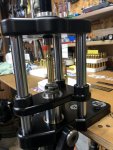Today i had some time so i cut open Hornady and RCC brass. RCC brass as i stated in previous post holds pressure much better. I did some measurements and it was impressive. At 80.01 no pressure with RCC brass. I also called Jeff at RCC to gather more info on this brass and everything made more sense. After i cut them open, here on picture you can see side by side RCC constructed like a Tank. Especially around primer pocket its very visible, difference is huge and here are pictures.
View attachment 7187041
View attachment 7187030
As you can see RCC constructed much much stronger and better. But not only that RCC brass is made out of stronger material. Primer pockets hold much better because around primer pocket its much more thicker material than Hornady Brass.
I also got in contact with Jeff at RCC and he is just very smart and know his stuff when it comes to making top line bras that's for sure.
This is from RCC because i had questions how its made and why it's so different and so good.
HERE IS SOME VERY INTERESTING INFO ABOUT RCC BRASS FROM JEFF at RCC
The problem a lot of people have is finding quality brass for the caliber they shoot. We manufacture high quality cartridges for vintage, obsolete, hard to find and wildcat calibers. All cartridges are made to SAAMI, CIP or tolerances provided to us. Our unique process allows us to manufacture over 1,400 different cartridges at tolerances up to 0.0005”. We can manufacture brass cartridges for any firearm, and if you are seeking quality products made in the USA, then you are at the right place.
The draw process has been used for cartridge manufacturing since the 19th century and manufacturers have been able to develop this process to produce high volumes of brass cases. Draw cartridge manufactures have tested many different types of materials over the years and the best material for this process is a brass alloy with a mixture of 70% copper and 30% zinc.
When brass is annealed at 250° C there is no visible change to the bonding of the grain structure, tensile strength and elasticity. At 300° C there is a microscopic change to the grain structure and at 350° the work hardness becomes softer and a fine grain structure can be seen. As temperatures increase the brass becomes fully annealed at 750° C and large crystals can be seen. Temperatures above this point will cause damage to the brass and at 800°C the brass is burned and should be scrapped.
When brass is cold-worked it hardens and done by bending, drawing, compressing and so forth. This increases the tensile strength and decreases it’s elasticity. To accommodate todays high pressure cartridges brass must both have a high tensile strength to withstand pressure spikes and elasticity to seal the chamber from any gas blow back.
The draw process begins using a brass cup that is annealed and cleaned to remove any scale build up that might have occurred. During the first draw the cup is pushed through a die with a punch and extruded to lengthen the cup. It has become work hardened and has to be annealed and washed for the second draw. Typically a cartridge will go through 4 draws before it is ready to go to the next stage. The case head will be turned, primer pockets, flash holes, head stamps and necks are done to complete the manufacturing process. When the neck is formed the cartridge is annealed again and is then polished for shipping. During each annealing, the temperature is reduced to work harden the case for higher tensile strength and elasticity. The final annealing is to the body of the case and is at a lower temperature, so it won’t affect the case head hardness.
While the draw process is capable of mass production, it is not able to easily produce consistence case head hardness, case weight, case volume and case concentricity. At RCC Brass™ we have taken those variables out of the manufacturing process as we have our C260 cartridge brass hammer forged into a tight molecular grain structure with a high tensile strength and 15% elasticity. We machine all our cases on CNC lathes and mills and our case weight, case volume and our case concentricity are the best available in the industry. We don’t anneal the case head as it is hammer forged to a high tensile strength which gives us the same hardness for each case. Since we are use CNC equipment to manufacture our, case weight is nearly identical, the case volume is too, and our case concentricity is held to a 0.001”.
Since we are not held back by the limitations of a draw system, we are able to use higher strength alloys to manufacture cartridges. Our new C272 brass alloy has a much higher tensile strength and tighter molecular grain structure than C260 brass, without losing the needed elasticity. Test results have been very positive as we’ve had reports of increased in velocity and energy and lower shot deviations versus C260 drawn brass. But the test is what you can do with RCC Brass™.
We are proudly Made in the U.S.A.
RCC brass is not for anyone but if you want the best i don't regret spending my $$$ on RCC because its nothing short of impressive.
Will be doing some more testing here soon and will keep you posted guys about SD and extreme spread.


